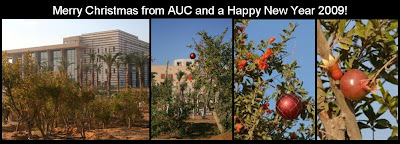 This evening I managed to photograph a bulbul for the second time on campus. Apparently, they are difficult to capture, so I am particularly pleased.
This evening I managed to photograph a bulbul for the second time on campus. Apparently, they are difficult to capture, so I am particularly pleased.The bulbul conjures fantasy images and mystic feelings because it occurs in many eastern tales. In Arabic, we often use the name bulbul for members of the bulbul family as well as (mistakenly) for nightingales. Be that as it may, I like bulbuls and love their call.
Pycnonotus barbatus is one of the many birds that found a home in the new gardens of AUC. It is about 18cm long, its head is very dark, the wings and tail are dark gray, the throat and back are also dark but slightly mottled, while the underside is light. The common bulbul is a resident bird in Egypt that breeds throughout Africa. It is luckily considered of Least Concern (IUCN 3.1) on the IUCN Red List of species. Mind you, "common" is a relative term. It is common as far as bulbuls go, but there was only one bulbul among quite a flock of sparrows today.
If you want to observe one, spend some time near the portal before sunset (currently around 5h30 pm). Wait, watch, and look closely. You might see it sitting high in the building to the left as you walk towards the portal. It will eventually come down to the ficus trees on your left, where it feeds on the ripe orange figs. If you are lucky, you might see it perched on an outer branch. Most probably though, you will need to look closely into the crown of the trees and be very patient. Listen intently for a voice that is different from the rest of the chirping, its call is clearly distinguishable amidst the racket of the sparrows.
References
Birdguides: http://www.birdguides.com/species/species.asp?sp=120023
Wikipedia: http://en.wikipedia.org/wiki/Common_Bulbul










